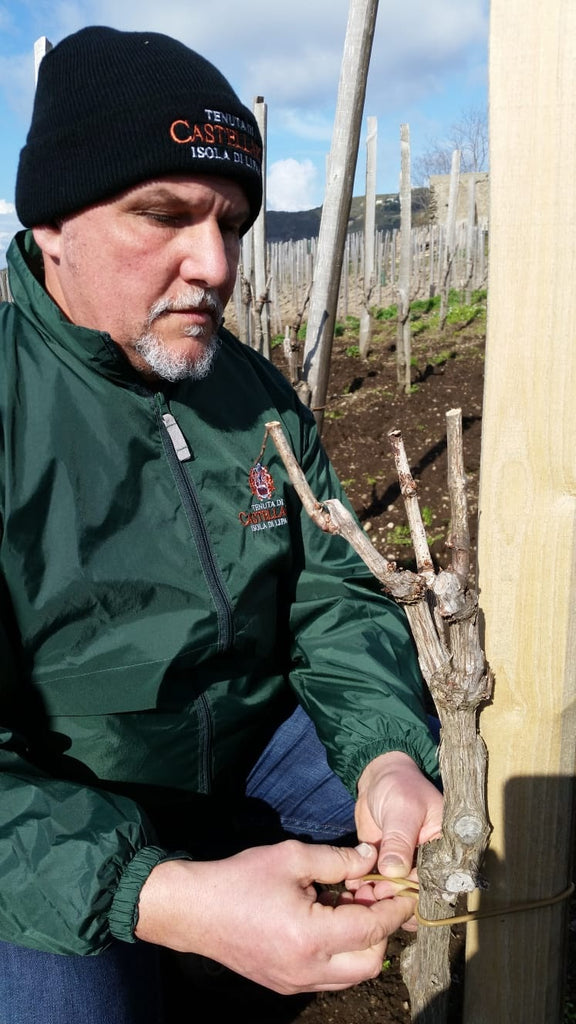Our tasting impressions
Take Nerello Mascalese from an Etna vineyard at high-elevation, very old vines and ungrafted roots from a masterful producer and you can imagine the kind of rosé that will result. This is so rich in volcanic minerals that the gorgeous red fruit is almost an afterthought. Massimo recommends giving this wine at least a year to settle in and then aging it for up to 5 years. It does indeed taste a bit closed. This is not your everyday poolside sipping blush wine. This is serious Etna Nerello that happens to be pale in color. Just don't expect it to slap you in the face with its charms - they are subtle but distinct.
About this wine
Oma means mother in Massimo's South Tyrolean dialect and this Rosato is a tribute to his mamma.
The vineyard is at 700m in the Contrada of Feudo di Mezzo on Etna's northern slope. The soil is volcanic sand that is rich and fertile. The Nerello Mascalese vines, some planted 100 years ago and many with original rootstock, are trained in the Albarello system. Harvesting is by hand with careful selection of bunches.
The grapes are pressed in a soft way. Static cold clarification is performed on the must. Fermentation is in steel tank at controlled temperatures, where the wine remains on its fine lees for at least 4 months before bottling. It is released after 2 more months.
About the grape
Nerello Mascalese is the grape most associated with Etna. Elsewhere in Sicily, it is predominantly a blending variety. But, in Etna’s high elevation, climate and mineral-rich, volcanic soil, it plays a starring role. It is dark-skinned, late-ripening and acidic. It is not uncommon to liken it to Nebbiolo and Pinot Noir.
Massimo's view of the vintage
2019 turned out to be a typical Etna vintage, with slight rainfall also recorded in the summer on the vineyards that are over 600 meters above sea level, and with the usual temperature changes between day and the night. This helped refresh the grapes and enhance their aromatics, in particular for the Nerello Mascalese, which was harvested on September 25th for the Rosato and in mid-October for Etna Rosso. The resulting wines are fragrant and with very fine and integrated tannins, and above all with a great evolutionary potential.
Suggested Glassware: Grassl Liberté
Massimo Lentsch is atypical among the winemakers in the VDLT Community, as he was not born into grape farming. He had a successful export business, which included a major wine estate. But always, wine was a passion. He discovered Lipari, the largest of the Aeolian Islands, north of Sicily during a sailing excursion. He decided immediately to establish Tenuta di Castellaro in 2005. His wines from 20ha of vineyards have become widely admired.
In 2018, he created another Azienda in Etna. Though nearby, and similarly volcanic, they are widely divergent - and Etna is a much more competitive region. The new estate, which bears his name, is 10.4ha on the slopes of Mount Etna, in the Province of Catania. It is in the communes of Castiglione di Sicilia and Randazzo, in the Contrade (Districts) of Feudo di Mezzo, Caldera Sottana, Chiusa Politi and Pianodario.
His vineyards are at high elevations so they are rich in volcanic soil. They are organically farmed, mostly by hand. In keeping with his commitment to local traditions, Massimo employs the head-trained system in Lipari and the Albarello training system in Etna to manage his vines. Amazingly, harvesting is considered on a per-vine basis.
Massimo’s passion and dedication are palpable. He blends respect for the past with entrepreneurship to produce wonderfully terroir-driven, yet distinct wines. It seems like there is no stopping him!
